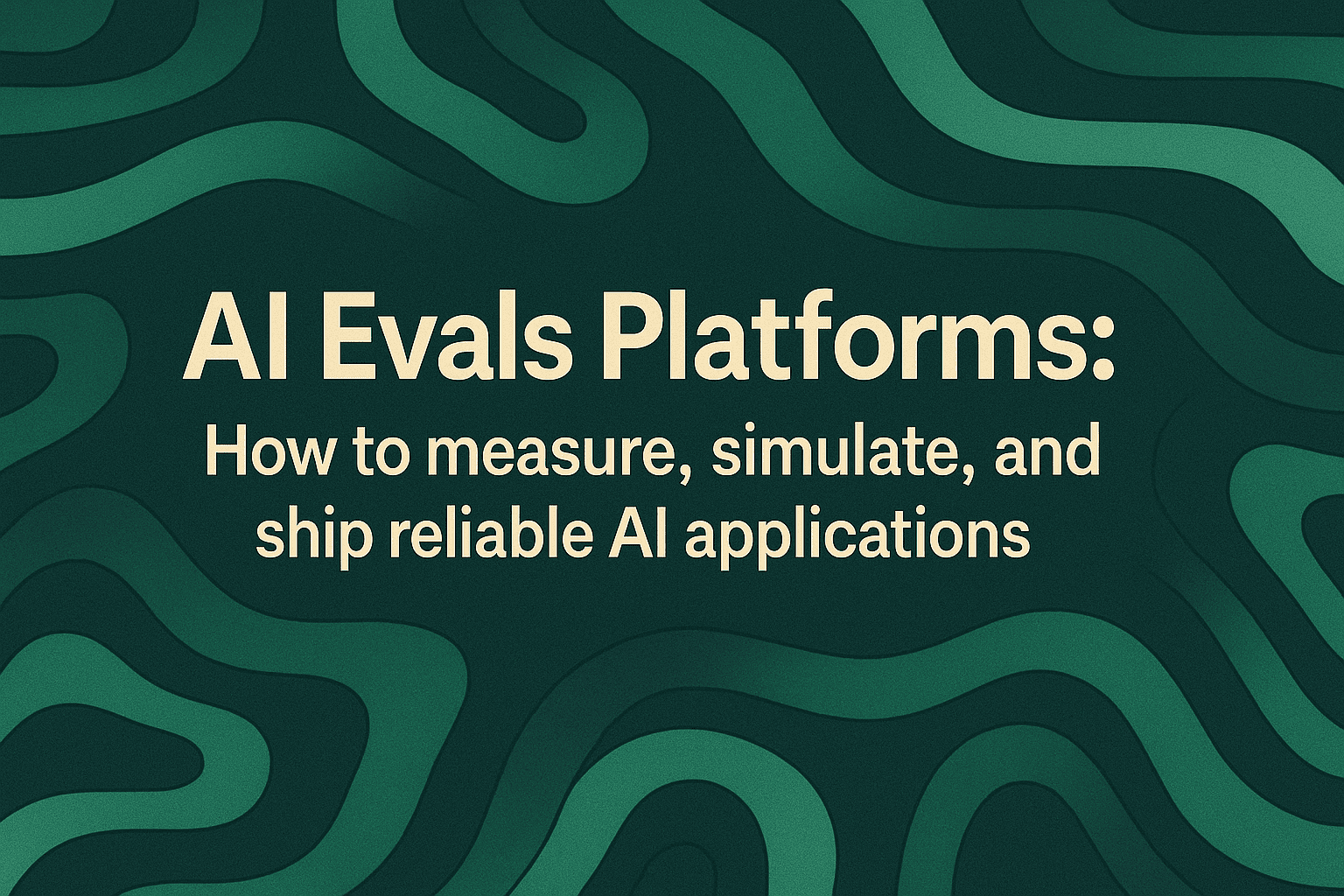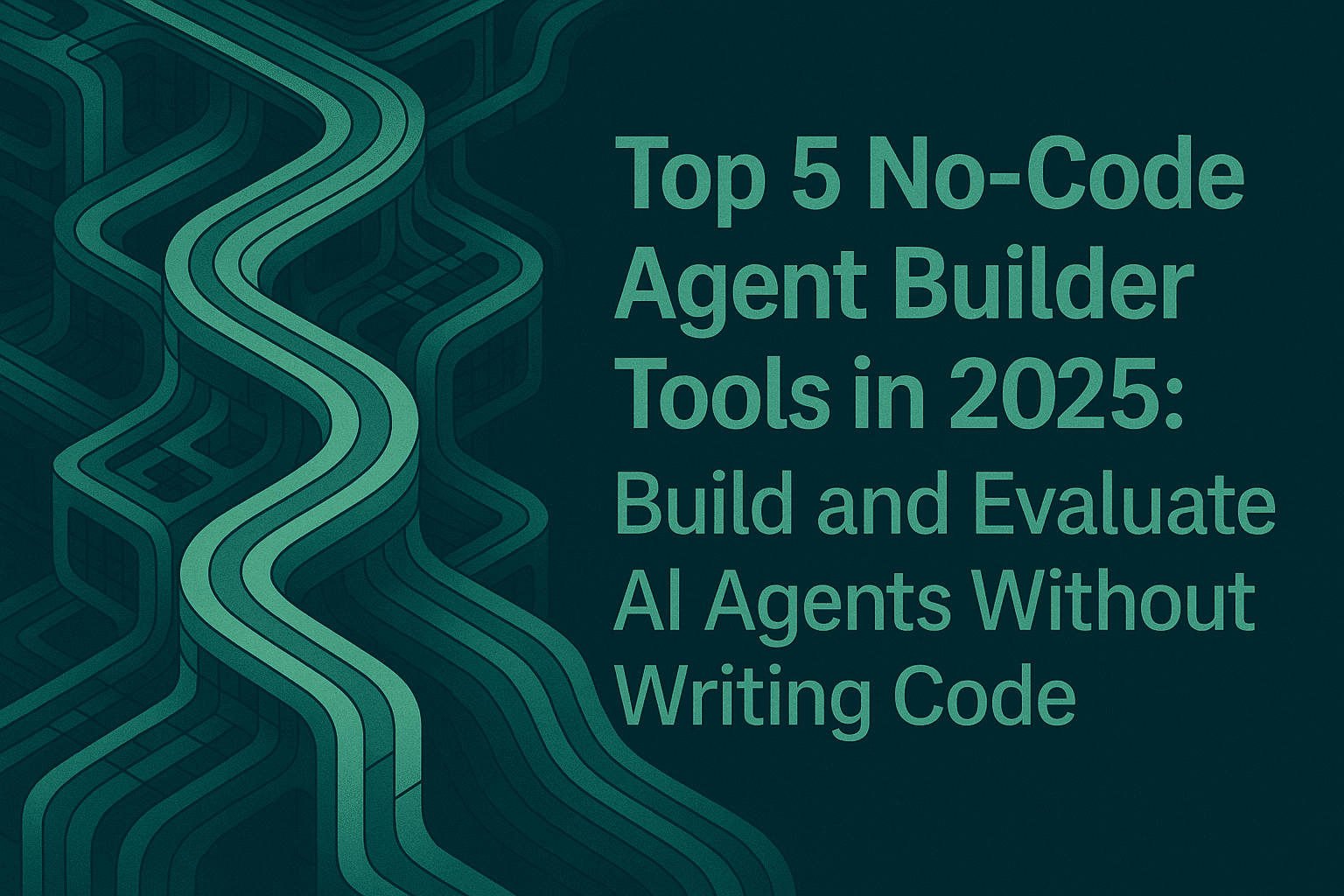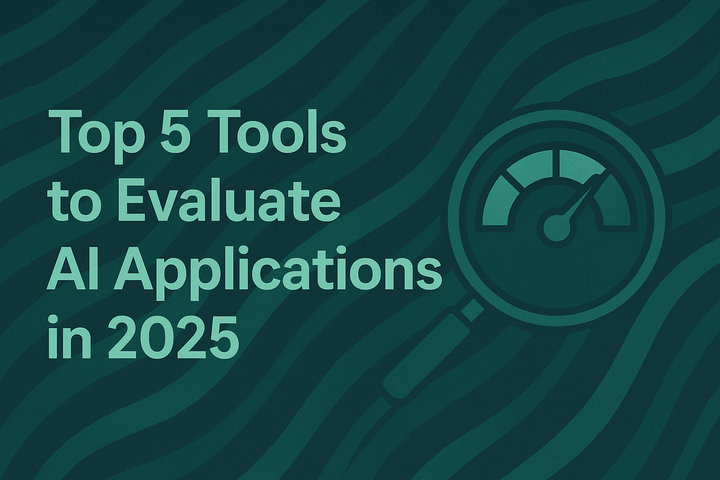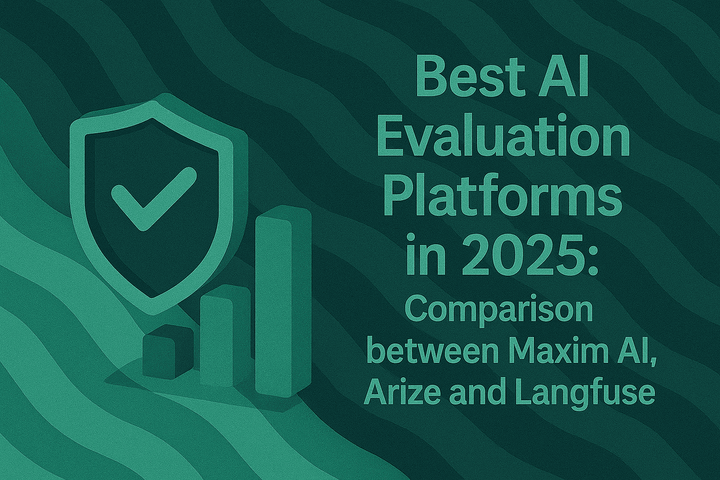AI Evals Platforms: How to measure, simulate, and ship reliable AI applications

Evaluating large language models (LLMs), retrieval-augmented generation (RAG), and multimodal agents is no longer optional, it is essential for ensuring AI quality. AI evals platforms give engineering and product teams a common framework to quantify quality, trace decisions, detect hallucinations, and compare changes before they reach production. This guide explains how AI evals platforms work, where traditional benchmarks fall short, and how to operationalize end-to-end evaluation, simulation, and observability using a modern stack. It also highlights how Maxim AI’s full-stack approach (spanning experimentations, simulations, evals, observability, and data management) reduces time-to-reliability while giving teams granular control and visibility.
Why AI evals matter now
Benchmarks and evals underpin trust in AI systems. Public leaderboards and tasks like MMLU, GSM8K, and HumanEval established standardized baselines and metrics such as accuracy, exact match, BLEU/ROUGE, and pass@k for code. These are useful but incomplete: they rarely reflect your domain-specific requirements, live instrumentation, or multi-step agent behavior. Even industry primers emphasize that static benchmarks cannot predict real-world behavior, suffer from data contamination, and lose relevance as models advance. See overview on benchmarking limitations in IBM’s guide to LLM benchmarks: What Are LLM Benchmarks?.
For production AI systems (chatbots, copilots, and tool-calling agents) you need evals that:
- Measure end-to-end correctness across conversations and workflows, not just single prompts.
- Diagnose failure modes with distributed agent tracing, not just aggregate scores.
- Combine deterministic metrics, statistical checks, and LLM-as-a-judge for qualitative criteria.
- Integrate with CI/CD, run A/B tests, and perform regression detection on live traffic.
Maxim AI’s platform was built for this exact need. Explore the products:
- Experimentation for advanced prompt engineering and versioning: Experimentation
- Agent simulation and evaluation for scenario-based agent quality: Agent Simulation & Evaluation
- Agent observability for real-time tracing and quality gates: Agent Observability
What an AI evals platform should include
Unified evaluator framework: deterministic, statistical, and LLM-as-a-judge
Modern AI evals require three complementary evaluator types:
- Deterministic evaluators: exact match, regex, numerical comparisons, and task-specific programmatic checks.
- Statistical evaluators: BLEU/ROUGE for summarization, calibration metrics, and distribution comparisons.
- LLM-as-a-judge: scalable judgments for coherence, helpfulness, style, and instruction-following when ground truth is unavailable.
Designing reliable LLM-as-a-judge is non-trivial. Recent research finds that eval design choices (criteria clarity, sampling, and prompts) materially affect alignment with human judgments; non-deterministic sampling can improve alignment over deterministic scoring, and chain-of-thought adds marginal benefit when criteria are explicit. See: An Empirical Study of LLM-as-a-Judge and the broader survey: A Survey on LLM-as-a-Judge.
Maxim’s evaluator stack supports all three modes, configurable at session, trace, or span level, and tightly integrated with human-in-the-loop workflows. Learn more on the product page: Agent Simulation & Evaluation.
RAG evaluation: fact, fetch, and reason
RAG systems must be judged across retrieval quality, grounding/faithfulness, and reasoning over multi-hop contexts. Unified approaches evaluate factuality, retrieval relevance, and reasoning in a single pipeline, acknowledging that correct answers may depend on multi-step, multi-source evidence. See a unified evaluation perspective in FRAMES: Fact, Fetch, and Reason and ongoing surveys that categorize retrieval and generation metrics (relevance, accuracy, and faithfulness) and their limitations for dynamic knowledge sources: Evaluation of RAG: A Survey and RAG Evaluation in the Era of LLMs.
Maxim natively captures retrieval spans, document diagnostics, and agent reasoning trajectories via distributed tracing. Pair this with custom evaluators for context relevance, faithfulness, and QA correctness to build domain-grounded eval suites. See observability primitives and tracing concepts: Agent Observability.
Agent simulation: multi-turn voice and chat agents under real scenarios
Static tests cannot surface complex failures in multi-turn agents, especially voice agents or tool-calling workflows. Simulation lets you:
- Run hundreds of real-world scenarios across diverse personas.
- Inspect the agent’s trajectory, decision points, and tool usage.
- Replay from any step to reproduce issues and pinpoint root causes.
Maxim’s simulations evaluate agents at a conversational level and integrate with evaluators to measure pathway correctness, success rates, hallucination detection, and latency/cost profiles. Explore: Agent Simulation & Evaluation.
Observability and AI tracing: from spans to session-level quality
Observability is the backbone of trustworthy AI. An evals platform should collect:
- Session-level logs for multi-turn conversations.
- Trace-level breakdowns with spans for model calls, tool calls, and retrievals.
- Generation metadata (model, parameters), cost, and latency.
- Automatic and human evaluations attached to traces and sessions.
Maxim’s observability suite is OpenTelemetry-compatible and purpose-built for LLM workflows—spans for model generations, retrievals, and tool calls; events and feedback; and native alerts to catch regressions in production. See how it works: LLM Observability: How to Monitor LLMs in Production.
Data engine: curate high-quality, multimodal datasets
Evals are only as good as the datasets behind them. A robust platform must:
- Import and manage multimodal datasets with clean versioning.
- Continuously curate from production logs using failure samples and feedback.
- Support human labeling and review loops for nuanced criteria.
- Create splits for benchmark vs. live traffic vs. regression tests.
Maxim’s data workflows attach directly to simulation, evaluation, and observability pipelines, enabling iterative improvement and precise targeting of edge cases. See: Agent Simulation & Evaluation and Agent Observability.
Operational patterns: online vs. offline evals, and CI/CD integration
An AI evals platform should support both offline and online modes:
- Offline evals (pre-release): Run large test suites across candidate prompts, models, and parameters; compare regressions, costs, and latencies; visualize improvements at session, trace, and span levels. Use this for experimentation and prompt engineering in Maxim’s Experimentation.
- Online evals (production): Sample live traffic to detect drift in correctness, relevance, and safety; auto-score using rules and LLM judges; attach human reviews for last-mile quality; enforce quality gates with alerts. See production-quality monitoring in Agent Observability.
For end-to-end reliability, integrate both modes with CI/CD to block deployments that degrade critical metrics and automatically promote changes that meet threshold improvements. Maxim supports automated pipelines, alerts, and dashboard comparisons of eval runs across versions: Agent Simulation & Evaluation.
Platform decisions: choosing evaluators, metrics, and coverage
A practical decision framework for AI evals platforms:
- Define task-level goals: correctness, helpfulness, compliance, or cost/latency targets. Select metrics accordingly (exact match for deterministic tasks; BLEU/ROUGE for summarization; programmatic checks for API actions; LLM-as-a-judge for instruction-following quality). See benchmark metrics overview and limitations: What Are LLM Benchmarks?.
- Layer evals by system component:
- Router: tool selection precision and parameter extraction accuracy.
- RAG: retrieval relevance, groundedness/faithfulness, conciseness.
- Generations: adherence to format, toxicity filters, hallucination detection.
- Conversation: trajectory convergence, loop detection, step count budgets.
- Cover real-world conditions via simulation:
- Create scenario libraries for normal, stress, and adversarial cases.
- Track agent convergence to optimal paths, measure divergence and loop rates.
- Debug with span-level traces and replays. See Maxim’s simulation suite: Agent Simulation & Evaluation.
- Operate with observability:
- Instrument spans for model, tool, and retrieval calls; log metadata and errors.
- Correlate quality signals with cost/latency at session and trace levels.
- Automate alerts for anomalies and regressions. Learn more: LLM Observability.
Maxim AI: a full-stack evaluation, simulation, and observability platform
Maxim’s approach is full-stack and multimodal, optimized for engineering and product teams:
- Experimentation: Advanced prompt engineering with versioning, deployment variables, and comparison across models and params—without code changes. Connect to databases and RAG pipelines to quantify quality, cost, and latency. See: Experimentation.
- Simulation: AI-powered simulations that evaluate multi-turn conversations across scenarios and personas, with end-to-end agent quality metrics and re-run capabilities from any step to reproduce issues. See: Agent Simulation & Evaluation.
- Evaluation: Unified framework for machine and human evals; off-the-shelf evaluators from an evaluator store; custom evaluators for domain needs; and visualization of evaluation runs at scale. See: Agent Simulation & Evaluation.
- Observability: Real-time production logs, distributed tracing, periodic quality checks, alerts, and dataset curation from production for continuous improvement. See: Agent Observability.
- Data Engine: Curate and enrich multimodal datasets; import images; evolve datasets with logging, evals, and human-in-the-loop workflows; create targeted splits for experiments and simulations. See capabilities across the product pages above.
- Bifrost (AI gateway): Unify access to 12+ providers behind a single OpenAI-compatible API; automatic failover, load balancing, semantic caching, governance, and observability for AI traffic. Explore the docs: Unified Interface, Multi-Provider Support, Automatic Fallbacks, Semantic Caching, Observability, and Governance & Budget Management.
Maxim’s design is anchored in how AI engineering and product teams collaborate on agentic applications, with powerful SDKs and an intuitive UI that lets cross-functional teams run evals, build custom dashboards, and move from pre-release to production seamlessly.
Putting it all together: trustworthy AI through evals + observability
A modern AI evals platform is not just about scoring outputs—it’s about understanding decisions and making reliability repeatable. The research community continues to refine best practices for benchmarking and judgment, particularly in open-ended tasks and RAG workflows. See foundational perspectives and evolving methodologies here:
- Benchmark scope, metrics, and limitations: What Are LLM Benchmarks?
- Unified RAG evaluation across factuality, retrieval, and reasoning: Fact, Fetch, and Reason
- Surveying RAG evaluation datasets and metrics: Evaluation of RAG: A Survey, RAG Evaluation in the Era of LLMs
- Reliability considerations for LLM-as-a-judge: An Empirical Study of LLM-as-a-Judge, A Survey on LLM-as-a-Judge
Maxim’s full-stack platform operationalizes these ideas with practical workflows—agent simulations, flexible evaluators, distributed tracing, human + AI-in-the-loop, and enterprise-grade governance—so teams can measure, debug, and improve AI quality with confidence.
Ready to evaluate and ship reliable AI agents end to end? Book a demo: Maxim AI Demo or get started: Sign up to Maxim.


